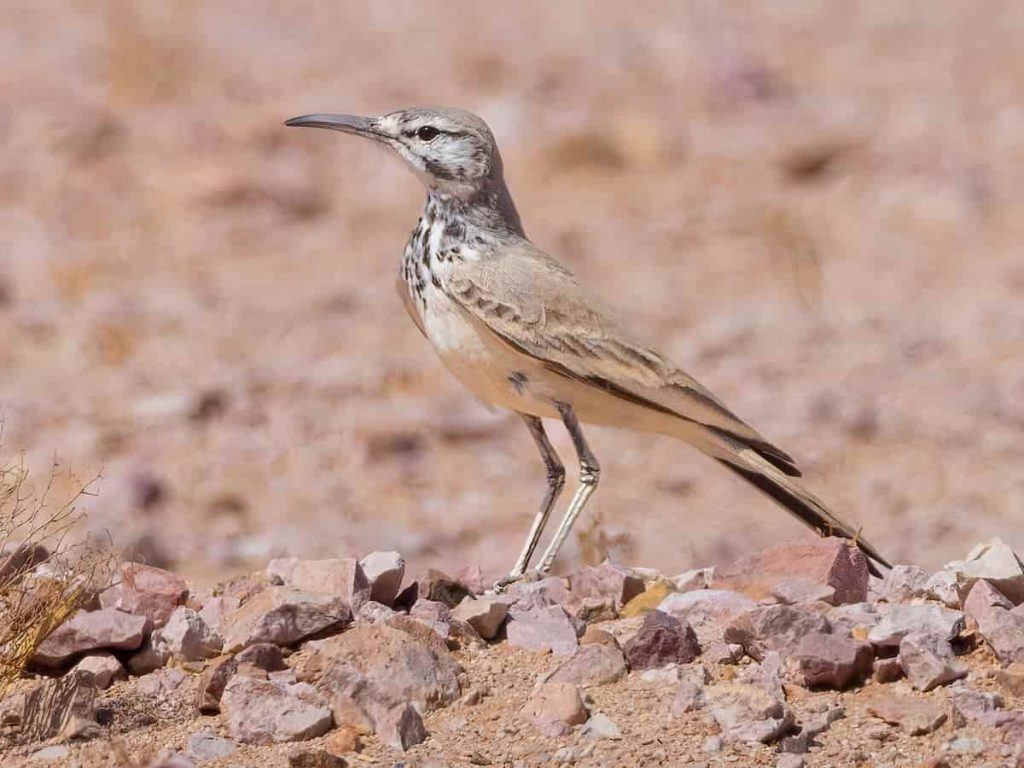Greater Hoopoe-lark the scientific name for this bird known as Alaemon Alaudipes is a rare species of a small bird that is found in north Africa exactly in the deserts of Morocco and Mauritania and it belongs to the family Alaudidae, it is found also in some other areas like an Arabian peninsula, Syria, Afghanistan, Pakistan, and India but with different characteristics and appearance.
This bird is considered a unique and special species as it is lovely by many bird watchers because it has amazing characteristics and appearance. I’m going to show you in this article any information about this bird’s places that he lives in, what he eats, how he survives in deserts, his appearance, and his physical description. I will take you on an imaginary trip about it.

Physical description:
The Hoopoe-lark size is medium and typically measures around 19-21cm in length and its wingspan of 32 to 34cm almost the same size as the Desert Sparrow its legs and feet are long and skinny, and thin legs are pinkish-brown in color. Its feet are also pinkish-brown and are relatively large and strong for a lark, and it has a white-brown and long beak. Its eyes are a darker brown with a black loop around them.
The amazing feature in this bird and what makes it aesthetic is its colors as it is available in amazing colors like a black and white striped head, which includes a long and pointed crest on its forehead, The lines on its head extend downwards and there is a dark-brown point in the middle of its beak which the lines meet there.
The other places in its body are sandy in color with some dark-born and black lines in its wings, These lines in the wings don’t display when it stays on the ground, they appear only when it opens its wings while flying.
The difference in size between males and females does not appear so much, sometimes you will find the male larger than the female a little, and the male’s peak is a little more than the female’s.
Taxonomy & systematics:
The greater hoopoe-lark belongs to the family Alaudidae, which includes more than 98 species of larks, and this one we can put it in the type that prefers to live in places that are harsh and known for the highest hot temperatures.
The scientific name is Alaemon alaudipes, The genus name Alaemon derives from the Greek word “Alaimon” which means “hardy” or ‘though” and the species name Alaudipes means “lark-footed.”
This bird has a long and complex taxonomic history, Scientists previously put it in its own monotypic genus, and the reason for that is due to its distinctive appearance and characteristics, but recent studies and research have proven that this type belongs to Alaudinae and it should be with Certhilauda family, because its have similar characteristics and appearance.
And now there are two types of Hoope-larks that are recognized, the first one is ladies that are located in North Africa, Morocco, and Mauritania in the west to Egypt and Libya in the East.
The second species is The Saharae found in the Sahel region of Africa from Senegal, Mauritania, and Sudan.
Habitat:
It’s found in arid and semi-arid areas habitats, including deserts, rocky terrain, and steppes, It is found in areas that know very high temperatures and where dry and scattered grasses and sandy soils are present.
Breeding:
The Greater Hopoe-Lark lays its nest in empty areas of people and this feature also found in the Pharaoh Eagle-Owl which is also don’t like to live in places where humans exist, forests, holes in the wall of abandoned building, or in the tops of a tree branch, and it breeds often at the end of spring and early summer. The female lays 2-4 eggs and both parents incubate them for about 14 days, after which the chicks come out. After that, both parents also take care of them, as one of the parents sits with them, and the other goes out to search for food, and vice versa.
Vocalizations:
This bird enjoys a wonderful and very beautiful voice, which is described as “trilling”, They often sing while flying or sitting in the ground or on a rock in a high place, Scientists could not identify the reason for issuing these sounds, is it an expression of joy or sadness.
Adaptations:
Living in the harsh deserts with some other birds like Desert Wheatear and in the hot places that are known for their high temperature is not easy, especially for these small birds, that’s why they are forced to change some characteristics and strategies to keep living in this hard places, And from things that keep it resist and be patient with high temperatures is its thick layer of feathers on the underside of its body and a long bill to search for food in the dunes like wheat grain and some small insects.
Diet:
In the desert there is nothing to eat for these birds, the only thing that is available in these empty places is Insects ants, and some other small invertebrates. Their favorite places are often the ground where they spend most of their time looking for insects and Dry grains of sage in the ground. it’s against to Egyptian Nightjar because this bird prefers to hunt and search for food at night and the greater hoopoe-lark is the opposite.
Social behavior:
Often you will find these birds in groups of about 20 individuals, or you can find them in the form of pairs, and they love to live away from humans and their noise.
Behavior In Flight:
This bird’s behavior in flight is considered unique and amazing because it flies at a low height Over the fields and swamps with a nice movement, thanks to its long wings and slender body, during the breeding season males perform air courtship displays in groups, known as sky dances, to impress females and accept mating with them.
Distribution and Population:
According to the International Union for Conservation of Nature, this species has no fear, meaning that it is not threatened with extinction, like the other desert species, because this species reproduces a lot. It is considered one of the most abundant birds in its range.
But this doesn’t mean it hasn’t any risks because human development like agriculture, preparation, infrastructure development, and other activities can negatively affect them, and this may lead to their extinction over time, meaning that it may take a long time.

